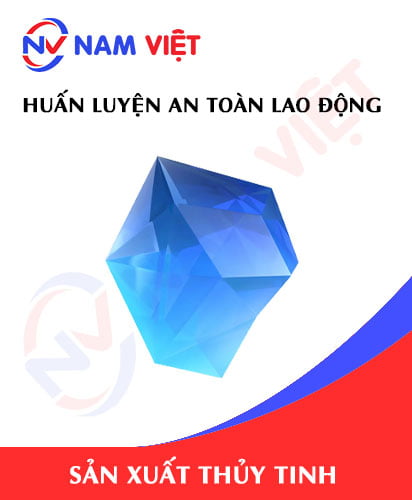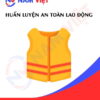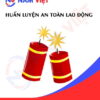Occupational Safety Training for Glass Manufacturing
99,000 ₫
Note: The above price is calculated per person and may vary depending on the number of participants in the course and market fluctuations. For more accurate pricing support, please refer to the price list or contact our consulting staff directly.
Occupational safety is an important issue in glass manufacturing factories and needs to be addressed promptly to ensure the health and safety of workers and enhance the reputation of businesses. The Occupational Safety Training course is one of the effective solutions to raise awareness of accident prevention for workers involved in glass manufacturing.
Table of Contents
Toggle1. Overview of Glass
a. What is Glass?
- Glass is a solid, transparent, and colorless material created by melting raw materials such as silicate, soda, and lime at high temperatures and then solidifying them upon cooling. Glass is malleable, allowing it to be shaped and cut as desired during production. It is used in a wide variety of applications, from household items like cups and bowls to the manufacture of windows, panels, construction materials, and electronic devices. Additionally, glass can withstand high temperatures, is durable, and is an important material in science and technology.
- In Vietnam, the glass manufacturing industry has developed strongly in recent years to meet domestic and export market demand. Glass manufacturers in Vietnam are mainly concentrated in the southern region, particularly in the provinces of Binh Duong, Dong Nai, and Tay Ninh.
- However, the glass industry in Vietnam still faces many challenges, including fierce competition from other countries in the region and globally, as well as shortages of raw materials and modern production technology. Therefore, to develop the glass industry in Vietnam, companies need to focus on improving product quality, enhancing research and development of production technologies, and investing in training and developing skilled and highly qualified personnel.

b. Glass Production Machinery
Glass production requires the use of various machinery and equipment, from melting to molding, cutting, polishing, and quality inspection. Some common machinery and equipment include:
- Glass Furnace: Used to melt raw materials such as mineral ores, sand, soda, and limestone into liquid to produce high-quality glass.
- Glass Mixer: Used to mix raw materials before placing them into the furnace.
- Glass Molding Machine: Used to press glass into different shapes such as cups, bowls, bottles, and plates.
- Glass Cutting Machine: Used to cut glass into various sizes and shapes while ensuring accuracy and product durability.
- Glass Polishing Machine: Used to polish and brighten the glass surface, enhancing its appearance and shine.
- Glass Quality Inspection Machine: Used to check technical parameters of glass products such as thickness, brightness, and strength.

c. Typical Glass Manufacturers in Vietnam
Several companies produce glass in Vietnam, with some notable examples including:
- VICASA Glass Group: A leading glass manufacturing and trading group in Vietnam, producing products such as bottles, cups, bowls, plates, and water containers.
- Hai Phong Glass Joint Stock Company: One of the largest glass manufacturers in Vietnam, producing glass water bottles, glasses, and containers.
- Saigon Glass Joint Stock Company: Specializes in producing and supplying glass products for both domestic and international markets, including cups, bowls, plates, and water containers.
- Dai Viet Glass Manufacturing Company Limited: A leading glass manufacturer in Vietnam, specializing in cups, bowls, plates, and water containers.
- Truong Thanh Glass Company Limited: Produces and trades glass products such as glass bottles, glasses, and water containers with internationally certified quality.
d. Specific Jobs in a Glass Factory
Group 1
- Chief Executive Officer, Deputy CEO, and department heads in the glass factory.
Group 2
- Safety Officers: manage safety within the factory, design safety procedures, and supervise employees to ensure compliance with safe working practices.
Group 3
- Material Preparation: Includes main raw materials such as limestone, sand, soda, dolomite, feldspar, and other additives.
- Material Mixing: Materials are mixed in appropriate ratios to create the glass mixture.
- Furnace Melting: The mixture is placed in the furnace to melt and become molten glass.
- Molding: The molten glass is poured into molds to create various glass products.
- Flattening: Glass sheets from molds may have imperfections and need to be flattened to produce finished products.
- Quality Inspection: Glass products are inspected for quality before packaging and shipping, ensuring standards are met.
Group 4
- Office, service, sales, and marketing jobs.
- Production management, quality management, human resource management, materials management, finance and accounting management.
- Research and development of new products, designing product packaging and models.

e. Glass Products
Glass is a versatile material used in many fields. Some glass products include:
- Dishes, coffee cups, glasses, water bottles, display shelves, glassware sets: used for food, beverages, or display purposes.
- Decorative lamps, table lamps, hanging lamps: glass is used for a variety of lamp designs.
- Tablets, smartphones: modern technology devices also use glass for screens.
- Mirrors, tempered glass, car windshields: glass is used for mirrors, tempered glass, car windshields, and window glass.
- Decorative items, glass sculptures: glass is also used for decorative items like sculptures, photo frames, vases, and ornaments.
- Medical products: glass is used to produce syringes, medicine bottles, and surgical instruments.
- Other products: such as glass vases, coffee cup sets, toys, and educational tools like microscopes and prisms.
2. Overview of Occupational Safety Training for Glass Manufacturing
In this article, we focus on Group 3 because Group 3 workers are directly involved in production and face the highest safety risks. For other groups, see here.
a. What is Group 3 Occupational Safety Training?
- Group 3 Occupational Safety Training provides workers with awareness and preventive measures against occupational accidents.
- This training helps workers identify hazards and reduce risks of workplace accidents.
REGISTER FOR OCCUPATIONAL SAFETY TRAINING SERVICE
b. Training Duration
Initial Safety Training Duration
- Total training duration is at least 24 hours, including examination time.
- 8 hours of theory on policies and labor safety laws
- 8 hours of theory on basic occupational safety knowledge
- 4 hours of theory on specialized training content
- 2 hours of practical training on specialized content
- 2 hours for final theoretical exam
Safety training centers usually divide this into multiple sessions depending on worker schedules, typically over 3 days with 6 sessions, provided the company arranges continuous learning time.
Periodic Safety Training Duration
- Before the occupational safety card expires, workers must undergo periodic safety training, with duration at least 50% of the initial training duration.
Explanation: The total periodic safety training duration is at least 12 hours, including examination time. After completing the periodic course and passing the exam, workers are issued a renewed safety card.
c. Training Content
| No. | TRAINING CONTENT | TRAINING HOURS | |||
| Total | Including | ||||
| Theory | Practice | Examination | |||
| I | Policies and labor safety laws system | 8 | 8 | 0 | 0 |
| 1 | Overview of legal documents related to occupational safety and hygiene. | 6 | 6 | ||
| 2 | Standards and technical regulations for occupational safety and hygiene. | 1 | 1 | ||
| 3 | Specific regulations from government agencies for new, expanded, or renovated production facilities, and requirements for machinery, equipment, materials, and substances with strict safety standards. | 1 | 1 | ||
| II | Basic occupational safety knowledge | 8 | 8 | 0 | 0 |
| 1 | Basic knowledge of workplace hazards and harmful factors. | 4 | 4 | ||
| 2 | Methods to improve working conditions. | 1 | 1 | ||
| 3 | Safety culture in production and business. | 1 | 1 | ||
| 4 | Rights and obligations of employers and employees; safety policies and regulations; role of safety network staff. | 1 | 1 | ||
| 5 | Occupational safety rules, safety signs, use of protective equipment, first aid skills, prevention of occupational diseases. | 1 | 1 | ||
| III | Specialized training content | 6 | 4 | 2 | 0 |
| Comprehensive knowledge of machines, equipment, substances causing hazards; risk assessment and management; safe work procedures with equipment and substances with strict safety requirements. | 6 | 4 | 2 | ||
| IV | Final exam for training course | 2 | 2 | 0 | 0 |
| Total | 24 | 22 | 2 | ||
See more training content for all 6 groups
d. Occupational Safety Card
After completing the safety training course and passing the exam, workers are issued a safety card (commonly called a Group 3 occupational safety certificate).
The Group 3 safety card displays information such as full name, date of birth, job, work environment, training duration, official stamp, and signature confirming course completion.
According to regulations in Clause 2 of Article 24, Decree 44/2016/ND-CP, there are two cases:
- If the employer and employee have a labor contract, the employer must sign, stamp, and endorse the safety card after the employee completes the Group 3 training and passes the exam.
- If the worker is freelance or seasonal without a labor contract, the training unit must sign, stamp, and endorse the safety card after the worker completes the training and passes the exam.

3. Identifying Hazards Affecting Workers in Glass Manufacturing
Glass manufacturing is an industry that requires careful attention to occupational hazards. The main hazards may include:
- During glass production, chemicals such as silica, ammonia, phosphorus, oxygen, hydrochloric acid, and hydrofluoric acid are used for manufacturing, cleaning, and processing glass. These substances can pose health risks to workers if not used properly and with adequate protection.
- The glass manufacturing process often requires extremely high temperatures, sometimes reaching thousands of degrees Celsius. Such temperatures can cause fires, explosions, burns to workers, or difficulties in breathing.
- Ultraviolet light is used in glass production to make the glass transparent and shiny. Ultraviolet light can harm the skin and eyes if workers are not properly protected.
- The use of large machinery in glass production can generate strong vibrations, which is a health hazard for workers, especially those who operate the equipment for extended periods.
- Machinery, equipment, and tools used in glass manufacturing can cause occupational accidents if not operated correctly or regularly maintained and inspected.
- If electrical equipment in the factory is not regularly maintained, properly insulated, or waterproofed, it can pose an electric shock hazard to workers during production.
4. Common Occupational Accidents for Workers in Glass Manufacturing
Common types of occupational accidents in glass manufacturing may include:
- Fire and explosion: The glass production process involves high temperatures and flammable substances, making the risk of fire and explosion very high. If safety measures are not properly implemented, fires and explosions may occur, causing serious harm to workers and property.
- Burns: Due to the high temperatures required in glass production, workers can suffer burns if they are not properly protected or do not use protective equipment.
- Machinery-related accidents: Using large machines and equipment during glass production can result in accidents such as entrapment, crushing, cuts, or injuries from collisions with machinery.
- Poisoning: Workers may be exposed to toxic chemicals such as silica, ammonia, phosphorus, oxygen, hydrochloric acid, and hydrofluoric acid. Without proper protection, poisoning can occur and negatively impact workers’ health.
- Injuries from falling objects: Glass production often requires moving large and heavy materials. If safety measures are not followed, these materials may fall and injure workers.

5. Safety Measures in Glass Manufacturing
Safety measures for participating in glass manufacturing include:
- Wearing full protective gear: Workers must wear full protective equipment, including helmets, safety glasses, masks, gloves, and safety shoes, to protect their bodies and minimize the risk of injury or chemical exposure.
- Following safety procedures: Workers must fully comply with the occupational safety procedures provided by the glass factory. If unclear, they should ask for guidance from experienced personnel.
- Using safety equipment: Workers must use safety equipment such as elevators, hydraulic cranes, sliding devices, and remote-controlled machinery to reduce the risk of injury.
- Regular equipment inspection: Machines and safety devices must be inspected regularly to ensure optimal functioning.
- Properly adjusting pressure and temperature: Correct adjustment of pressure and temperature is crucial in glass production. Workers must be trained to adjust these safely and correctly.
- Proper use of chemicals: Workers must handle chemicals safely and correctly. If necessary, they should be trained on the proper use of chemicals.
- Maintaining hygiene: Cleanliness is very important in glass manufacturing. Workers must maintain hygiene and keep their work area clean.
- Periodically conduct occupational environment monitoring in factories to collect and analyze harmful factors for workers, then adjust and reduce hazards to prevent occupational diseases.
6. Benefits of Glass Manufacturing Occupational Safety Training
An Toan Nam Viet provides enterprises with the following benefits after completing occupational safety training courses in accordance with Decree 44/2016/ND-CP on occupational safety and hygiene:
- Workers can identify potential occupational hazards and take preventive measures to avoid accidents.
- Enterprises can establish risk prevention measures in production, operation, and maintenance processes.
- Minimizes costs associated with safety hazards in labor.
- Uninterrupted production processes increase labor productivity and product quality.
- Ensures compliance with occupational safety laws and reduces legal risks.
- Enhances corporate reputation and professionalism, elevating the enterprise’s brand value.
An Toan Nam Viet training courses are solutions to prevent external hazards affecting individuals, helping them avoid dangers that could lead to injuries or even fatalities.
REGISTER FOR OCCUPATIONAL SAFETY TRAINING SERVICE
7. Customer Feedback after Completing Glass Manufacturing Occupational Safety Training
An Toan Nam Viet has many years of experience supporting enterprises across Vietnam. This responsibility is highly valued, so our Occupational Safety Training programs are increasingly professional. The motivation behind An Toan Nam Viet’s growth comes from both positive feedback and constructive suggestions from clients. Below are some testimonials from our partners.
Bac Nam E&C Construction Investment Joint Stock Company
“My first experience with An Toan Nam Viet was impressive due to the 24/7 support from the consulting team. The class organization was fast and convenient for our company. Thank you very much for Nam Viet’s service!”
Hoa Dat Construction and Trading Joint Stock Company
“Nam Viet’s service helped us simplify occupational safety and complete safety documentation for work processes. The consulting team is enthusiastic and responsive to our questions. Five stars for Nam Viet.”
See more customer interviews after using our services of An Toan Nam Viet
8. Occupational Safety Training Competency of An Toan Nam Viet
An Toan Nam Viet is a reputable and quality occupational safety training center in Vietnam, conducting continuous training sessions at production workshops, factories, or construction sites across all 63 provinces.
REGISTER FOR OCCUPATIONAL SAFETY TRAINING SERVICE
Occupational Safety Training License
- An Toan Nam Viet has been inspected and certified by the Department of Occupational Safety under the Ministry of Labor – Invalids and Social Affairs, confirming our eligibility for occupational safety and hygiene training. This further strengthens our capacity in occupational safety training.

Training Materials and Lectures
- Before being included in ATLĐ courses, all training materials are reviewed to ensure accurate knowledge and practical effectiveness.
- The teaching methods of our instructors follow the standards of An Toan Nam Viet, developed by experts in occupational safety and hygiene training to maximize learners’ knowledge absorption.
Facilities
- Controlling classroom conditions enhances teaching efficiency and learners’ knowledge retention.
- Our training facilities include spacious classrooms meeting standards for area, lighting, and training equipment, etc.
9. Nationwide Reputable Occupational Safety Training Center
At An Toan Nam Viet, we prioritize occupational safety training. Teaching workers self-protection skills equips them with safety knowledge for their work, contributing to national development.
To ensure training effectiveness, we carefully prepare every detail, from tools, teaching devices, curriculum, materials, sound, and lighting.
Our instructors are experienced specialists, with research on hazard identification across all industries and preventive measures.
Lectures are practical and engaging, helping workers comfortably absorb knowledge while aligning with Decree 44/2016/ND-CP.
Workers learn preventive measures and self-protection techniques that can be applied effectively in real work situations.
Our training center is proud to provide reputable, professional occupational safety training with the following advantages:
- Competitive training costs without compromising quality.
- Flexible training schedules according to company production.
- Fast certification procedures compliant with law.
- Experienced instructors.
- Classroom conditions optimized to enhance teaching and learning efficiency.
- Lectures tailored to occupational safety in enterprises.
- Dedicated and professional support for customers efficiently and accurately.

10. Additional Reference Materials for Glass Manufacturing Occupational Safety Training
- Glass Manufacturing Occupational Safety Materials
- Occupational Safety Training Materials Set
- Occupational Safety Training Test Set
- Glass Manufacturing Occupational Safety Quiz
- Glass Manufacturing Occupational Safety Training Slides
1 review for Occupational Safety Training for Glass Manufacturing
No comments yet















namchinh.haiphong341
Dịch vụ huấn luyện an toàn lao động rất tốt nhé, giảng viên dạy rất sinh động dễ hiểu!